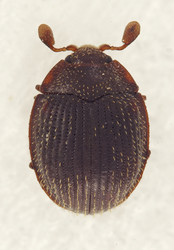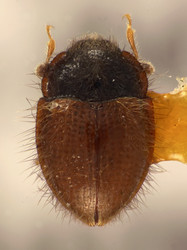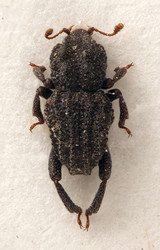Cerylonidae
Minute bark beetles
James A. Robertson, Adam Slipinski, and Joseph V. McHugh


This tree diagram shows the relationships between several groups of organisms.
The root of the current tree connects the organisms featured in this tree to their containing group and the rest of the Tree of Life. The basal branching point in the tree represents the ancestor of the other groups in the tree. This ancestor diversified over time into several descendent subgroups, which are represented as internal nodes and terminal taxa to the right.

You can click on the root to travel down the Tree of Life all the way to the root of all Life, and you can click on the names of descendent subgroups to travel up the Tree of Life all the way to individual species.
For more information on ToL tree formatting, please see Interpreting the Tree or Classification. To learn more about phylogenetic trees, please visit our Phylogenetic Biology pages.
close boxIntroduction
Cerylonidae, commonly known as the minute bark beetles, is a family comprising roughly 450 species classified in 52 genera and 5 subfamilies: Ceryloninae, Euxestinae, Loeblioryloninae, Murmidiinae, and Ostomopsinae (Ślipiński & Lawrence, 2010). Although the family occurs in all major zoogeographic regions of the world, cerylonids are most diverse and abundant in the tropics and forested areas of the subtropics (Ślipiński, 1990).
Information regarding the specific habits and habitats of cerylonids is relatively scarce. Cerylonids are commonly found under bark of rotten logs and in decaying leaf litter, where they probably feed on fungal hyphae and spores or slime molds. A few species of Ceryloninae and Euxestinae are associated with ants [e.g., Mychocerus hintoni (with Atta mexicana), Hypodacne punctata (with Camponotus spp.), and Euxestoxenus spp. (with Myrmicaria spp.) (Ślipiński, 1990; Ślipiński & Lawrence, 2010)]. Termite associations are restricted to fungus growing termites (e.g., Odontotermes) and occur only among members of Euxestinae (e.g., Cycloxenus, Euxestoxenus) (Ślipiński & Lawrence, 2010). Adults of some African species of Metacerylon are associated with tunnels of wood boring insects (Schedl, 1962) (e.g., ambrosia beetles), most likely feeding on fungi farmed within these tunnels. Murmidius ovalis is associated with stored products that have been contaminated with molds or yeasts (Halstead, 1968; Ślipiński, 1990).
Characteristics
Cerylonidae as presently constituted is such a morphologically diverse and heterogenous group that it is difficult to characterize. As their common name suggests, cerylonids are very small ranging from 0.8 to 4.5 mm in length (Ślipiński & Lawrence, 2010). In general, the body is broadly ovate to narrowly elongate, slightly to strongly flattened, and red to brown to black in color. The antennae have 6 to 11 articles and a compact antennal club that is typically 1 or 2-segmented (Ślipiński, 1990).
Ślipiński (1990) reviewed the taxonomic literature (e.g., Sen Gupta & Crowson, 1973; Lawrence & Stephan, 1975; Lawrence 1982; Pal & Lawrence, 1986; Ślipiński, 1988) and provided a summary of characters that can be used to recognize most cerylonids, including the following:
Adults:
- Antennal insertions exposed
- Scape and pedicel of antenna markedly asymmetrical with the pedicel inserted ventrally on the scape
- Antennal club compact and usually 1 or 2-segmented
- Corpotentorial bridge with median process
- Procoxae externally small and rounded with concealed lateral extensions
- Trochanters elongate or weakly heteromeroid
- Tarsal formula 4-4-4 or 3-3-3
- Tarsomeres simple or rarely with tarsomere 1 lobed below
- Tarsal claws simple
- Wing without radial cell
- Aedeagus with median lobe lying on its side, usually with strongly reduced phallobase (tegmen)
Larvae:
- With or without weakly developed frontal arms and no epicranial stem
- 0 or 2 stemmata
- Urogomphi absent or long and divergent
As discussed by Ślipiński (1990) and Ślipiński and Lawrence (2010), many of the above character states are probably plesiomorphic, occurring in other Cerylonid Series taxa. Additional adult characters relevant to Cerylonidae include (Ślipiński, 1990):
- Transverse occipital ridge often present
- Subantennal grooves usually distinct
- Frontoclypeal suture present (Murmidiinae, Ostomopsinae and Euxestinae) or absent (Ceryloninae and Loeblioryloninae)
- Maxillary palps aciculate (Ceryloninae and Loeblioryloninae)
- Wing with anal lobe absent (except Euxestinae)
- Hind coxae almost always widely separated
- Abdominal spiracles present on segments 1-5 (except Euxestinae, 1-7)
- Apical margin of last abdominal ventrite often crenulate (Ceryloninae, Ostomopsinae, Murmidiinae)
Taxonomy
Historically most cerylonids were treated as a distinct group within a broadly defined Colydiidae (= Zopheridae, Colydiinae) (Erichson, 1845; Horn, 1878; Emden, 1928; Hetschko, 1930). Crowson (1955), however, first proposed that the former colydiid taxa Cerylonini, Pachyochthesini, Anommatini, Murmidiinae and Euxestinae formed an independent family, Cerylonidae, which he placed within the superfamily Clavicornia (= Cucujoidea).
One of the most significant systematic treatments of Cerylonidae to date is Sen Gupta and Crowson’s (1973) review of the classification of the family. This review included redescriptions of all known genera, first descriptions for a number of larvae, and a new classification which divided Cerylonidae into three subfamilies: Euxestinae (incl. Euxestini, Metacerylonini, Anommatini), Murmidiinae (incl. Murmidiini, Ostomopsini) and Ceryloninae (incl. Lapethini, Cerylonini, Aculagnathini).
Another monumental contribution was Ślipiński’s (1990) monograph of the world cerylonid fauna which treated all subfamilies and genera, provided detailed descriptions and diagnoses, illustrated key characters, listed all included species, and summarized all known information about the immature stages, biology and distribution. In this treatment, Ślipiński described 12 new genera, proposed over 150 new combinations, synonymized 21 generic names, established a new subfamily (Loeblioryloninae), and provided a checklist and keys to the subfamilies and genera of the world. The monograph also included a new classification with five subfamilies (Ceryloninae, Euxestinae, Loeblioryloninae, Murmidiinae, and Ostomopsinae) which remains in place today.
Classification
(based on Ślipiński, 1990; Lawrence & Newton, 1995)
- Cerylonidae
- Subfamily Loeblioryloninae
- Loebliorylon
- Subfamily Ostomopsinae
- Ostomopsis
- Subfamily Murmidiinae
- Murmidius
- Mychocerinus
- Botrodus
- Subfamily Euxestinae
- Protoxestus
- Pseudodacne
- Hypodacnella
- Hypodacne
- Euxestus
- Euxestoxenus
- Cycloxenus
- Bradycycloxenus
- Globoeuxestus
- Metaxestus
- Metacerylon
- Subfamily Ceryloninae
- Philothermus
- Ectomicrus
- Pakalukia
- Glyptolopus
- Ploeosoma
- Coccilon
- Pathelus
- Ellipsorylon
- Acautomus
- Spinocerylon
- Gyrelyon
- Clavicerylon
- Pachylon
- Oroussetia
- Paracerylon
- Cerylon
- Pseudocerylon
- Australiorylon
- Orientrylon
- Afrorylon
- Philothermopsis
- Belingaia
- Nkolbissonia
- Suakokoia
- Ivieus
- Cautomus
- Glomerylon
- Lapethinus
- Rostrorylon
- Neolapethus
- Mychocerus
- Pseudolapethus
- Lawrencella
- Axiocerylon
- Thyroderus
- Angolon
- Subfamily Loeblioryloninae
Discussion of Phylogenetic Relationships
Little is known about the internal phylogenetic relationships of Cerylonidae. Pal and Lawrence (1986) discussed the position of Cerylonidae, Bothrideridae and related taxa and highlighted many problems with the constitution of these two families with respect to each other (see also Ślipiński, 1990). They transferred Anommatinae from Cerylonidae to Bothrideridae based on the form of the aedeagus, the spinose tibial apices and larvae with fixed upturned urogomphi and well-developed hypostomal rods (Pal & Lawrence, 1986). Both Pal and Lawrence (1986) and Ślipiński (1990) demonstrated that from a morphological standpoint Euxestinae could not be separated from free-living Bothrideridae (Anommatinae, Teredinae, Xylariophilinae). The enigmatic Metacerylonini (Euxestinae) in particular bears many morphological similarities to the above bothriderid taxa and was considered by Dajoz (1980) to be subordinate to Bothrideridae.
Ślipiński (1990) postulated a sister relationship between the diverse Ceryloninae and the monotypic Loeblioryloninae based on both possessing aciculate palps and lacking the frontoclypeal suture. Multiple authors have suggested a potential sister group pairing of Murmidiinae and the family Discolomatidae (Ślipiński, 1990; Lawrence, 1991; Ślipiński & Pakaluk, 1991). Murmidiine cerylonids and discolomatids share a number of adult and larval morphological features including adults with the spiculum gastrale absent and ovipositor reduced, without styli, and larvae onisciform (Ślipiński, 1990; Ślipiński & Pakaluk, 1991).
To date no formal phylogenetic analysis of Cerylonidae has been conducted. Nonetheless, a number of cerylonid exemplars were included in recent broad-scale phylogenetic studies of Coleoptera (Hunt et al., 2007) and the Cerylonid Series (Robertson et al., 2008). Neither of these studies proffers much insight regarding the internal cerylonid relationships due to the unrepresentative taxon sampling used for this family. Hunt et al. (2007) included two cerylonids representing the subfamilies Ceryloninae and Euxestinae. Interestingly these were not recovered as monophyletic in Hunt et al.’s (2007) analyses, again pointing to the potential paraphyletic nature of Cerylonidae with respect to Euxestinae. Robertson et al. (2008) used four cerylonid exemplars all of which belong to the subfamily Ceryloninae. Both studies (Hunt et al., 2007; Robertson et al., 2008) indicate a close affiliation of Bothrideridae, Cerylonidae, and Discolomatidae.
Other Names for Cerylonidae
- Aculagnathidae
- Dolosidae
- Euxestidae
- Murmidiidae
- Pleosomidae
- Vernacular Names: Minute bark beetles
References
Crowson, R. A. 1955. The Natural Classification of the Families of Coleoptera. Nathaniel Lloyd, London.
Dajoz, R. 1980. Insectes Coléoptères: Colydiidae et Cerylonidae. Faune de Madagascar. CNRS, Paris.
Emden, F. v. 1928. Die verwandtschaftliche Stellung von Euxestus nebst Beschreibung neur Arten der Gattung. Tijdschrift voor Entomologie 71:84-110.
Erichson, W. F. 1845. Naturgeschichte der Insecten Deutschlands. Erste Abtheilung, Coleoptera. Nicolaischen Buchhandlung, Berlin.
Halstead, D. G. H. 1968. Observations on the biology of Murmidius ovalis (Beck) (Coleoptera: Cerylonidae). Journal of Stored Product Research 4:13-21.
Hetschko, A. 1930. Colydiidae. Pages 124 in Coleopterorum Catalogus (W. Junk, and S. Schenkling, eds.). W. Junk, Berlin.
Horn, G. H. 1878. Synopsis of the Colydiidae of the United States. Proceedings of the American Philosophical Society 17:39-45.
Hunt, T., J. Bergsten, and Z. Levkanicova. 2007. A comprehensive phylogeny of beetles reveals the evolutinoary origins of a superradiation. Science 318:1913-1916.
Lawrence, J. F. 1982. Coleoptera. Pages 482-553 in Synopsis and classification of living organisms (S. P. Parker, ed.) McGraw-Hill Book Co., New York.
Lawrence, J. F. 1991. Cerylonidae (Coleoptera). Pages 480-481 in Immature Insects (F. W. Stehr, ed.) Kendall/Hunt, Publishing Co., Dubuque, Iowa.
Lawrence, J. F., and K. H. Stephan. 1975. The North American Cerylonidae (Coleoptera: Clavicornia). Psyche 82:131-166.
Lawrence, J.F. & A.F. Newton, Jr. 1995. Families and subfamilies of Coleoptera (with selected genera, notes, references and data on family-group names). Pp. 779–1092 In J. Pakaluk and S.A. Ślipiński (eds.), Biology, phylogeny, and classification of Coleoptera: papers celebrating the 80th birthday of Roy A. Crowson. Muzeum i Instytut Zoologii PAN, Warszawa.
Pal, T. K., and J. F. Lawrence. 1986. A new genus and subfamily of mycophagous Bothrideridae (Coleoptera: Cucujoidea) from the Indo-Australian region, with notes on related families. J. Aust. Entomol. Soc. 25:185-210.
Robertson, J. A., M. F. Whiting, and J. V. McHugh. 2008. Searching for natural lineages within the Cerylonid Series (Coleoptera: Cucujoidea). Molecular Phylogenetics and Evolution 46:193-205.
Schedl, K. E. 1962. Forstentomologische Beiträge aus dem Kongo. Räuber und Kommensalen. Entomologische Abhandlungen und Berichte aus dem staatlichen Museum für Tierkunde in Dresden 28:37-84.
Sen Gupta, T., and R. A. Crowson. 1973. A review of the classification of Cerylonidae (Coleoptera: Clavicornia). Trans. R. Ent. Soc. Lond. 124:365-446.
Ślipiński, S. A. 1988. Revision of the Australian Cerylonidae (Coleoptera: Cucujoidea). Annales Zoologici (Warszawa) 42:1-74.
Ślipiński, S. A. 1990. A monograph of the world Cerylonidae (Coleoptera: Cucujoidea) Part I - Introduction and higher classification. Annali del Museo Civico di Storia Naturale "Giacomo Doria" 88:1-273.
Ślipiński, S. A., and J. F. Lawrence. 2010. 10.29 Cerylonidae Billberg, 1820. pp. 422- 432 in Handbuch der Zoologie (R. G. Beutel, and R. A. B. Leschen, eds.). De Gruyter, Berlin.
Ślipiński, S. A., and J. Pakaluk. 1991. Problems in the classification of the Cerylonid series of Cucujoidea (Coleoptera). Pages 79-88 in Advances in Coleopterology (M. Zunino, X. Belles, and M. Blas, eds.). European Association of Coleopterology. Silvestrelli and Cappelletto, Torino.
Title Illustrations

| Scientific Name | Afrorylon sp. |
|---|---|
| Specimen Condition | Dead Specimen |
| Identified By | James A. Robertson |
| Sex | Male |
| Life Cycle Stage | Adult |
| View | Dorsal |
| Image Use |
 This media file is licensed under the Creative Commons Attribution-NonCommercial License - Version 3.0. This media file is licensed under the Creative Commons Attribution-NonCommercial License - Version 3.0.
|
| Copyright |
© 2010

|
| Scientific Name | Euxestoxenus sp. |
|---|---|
| Specimen Condition | Dead Specimen |
| Identified By | James A. Robertson |
| Life Cycle Stage | Adult |
| View | Dorsal |
| Image Use |
 This media file is licensed under the Creative Commons Attribution-NonCommercial License - Version 3.0. This media file is licensed under the Creative Commons Attribution-NonCommercial License - Version 3.0.
|
| Copyright |
© 2010

|
| Scientific Name | Ostomopsis sp. |
|---|---|
| Specimen Condition | Dead Specimen |
| Identified By | James A. Robertson |
| Life Cycle Stage | Adult |
| View | Dorsal |
| Image Use |
 This media file is licensed under the Creative Commons Attribution-NonCommercial License - Version 3.0. This media file is licensed under the Creative Commons Attribution-NonCommercial License - Version 3.0.
|
| Copyright |
© 2010

|
| Scientific Name | Loebliorylon magnus |
|---|---|
| Comments | Paratype |
| Specimen Condition | Dead Specimen |
| Identified By | Adam Slipinski |
| Life Cycle Stage | Adult |
| View | Dorsal |
| Image Use |
 This media file is licensed under the Creative Commons Attribution-NonCommercial License - Version 3.0. This media file is licensed under the Creative Commons Attribution-NonCommercial License - Version 3.0.
|
| Copyright | © 2010 |
About This Page
We thank all members of the McHugh lab for their assistance with this project. Support for the construction of this page was provided by an NSF AToL grant EF-0531665 to M.F. Whiting (subcontract to J.V. McHugh) and through an NSF PEET grant (DEB-0329115) to J.V. McHugh, M.F. Whiting, and K.B. Miller.

University of Georgia, Athens, Georgia, USA
Adam Slipinski

CSIRO, Australia
Joseph V. McHugh

University of Georgia, Athens, Georgia, USA
Correspondence regarding this page should be directed to James A. Robertson at , Adam Slipinski at , and Joseph V. McHugh at
Page copyright © 2011 , , and Joseph V. McHugh
 Page: Tree of Life
Cerylonidae. Minute bark beetles.
Authored by
James A. Robertson, Adam Slipinski, and Joseph V. McHugh.
The TEXT of this page is licensed under the
Creative Commons Attribution-NonCommercial License - Version 3.0. Note that images and other media
featured on this page are each governed by their own license, and they may or may not be available
for reuse. Click on an image or a media link to access the media data window, which provides the
relevant licensing information. For the general terms and conditions of ToL material reuse and
redistribution, please see the Tree of Life Copyright
Policies.
Page: Tree of Life
Cerylonidae. Minute bark beetles.
Authored by
James A. Robertson, Adam Slipinski, and Joseph V. McHugh.
The TEXT of this page is licensed under the
Creative Commons Attribution-NonCommercial License - Version 3.0. Note that images and other media
featured on this page are each governed by their own license, and they may or may not be available
for reuse. Click on an image or a media link to access the media data window, which provides the
relevant licensing information. For the general terms and conditions of ToL material reuse and
redistribution, please see the Tree of Life Copyright
Policies.
- Content changed 03 March 2010
Citing this page:
Robertson, James A., Adam Slipinski, and Joseph V. McHugh. 2010. Cerylonidae. Minute bark beetles. Version 03 March 2010 (temporary). http://tolweb.org/Cerylonidae/9166/2010.03.03 in The Tree of Life Web Project, http://tolweb.org/













 Go to quick links
Go to quick search
Go to navigation for this section of the ToL site
Go to detailed links for the ToL site
Go to quick links
Go to quick search
Go to navigation for this section of the ToL site
Go to detailed links for the ToL site